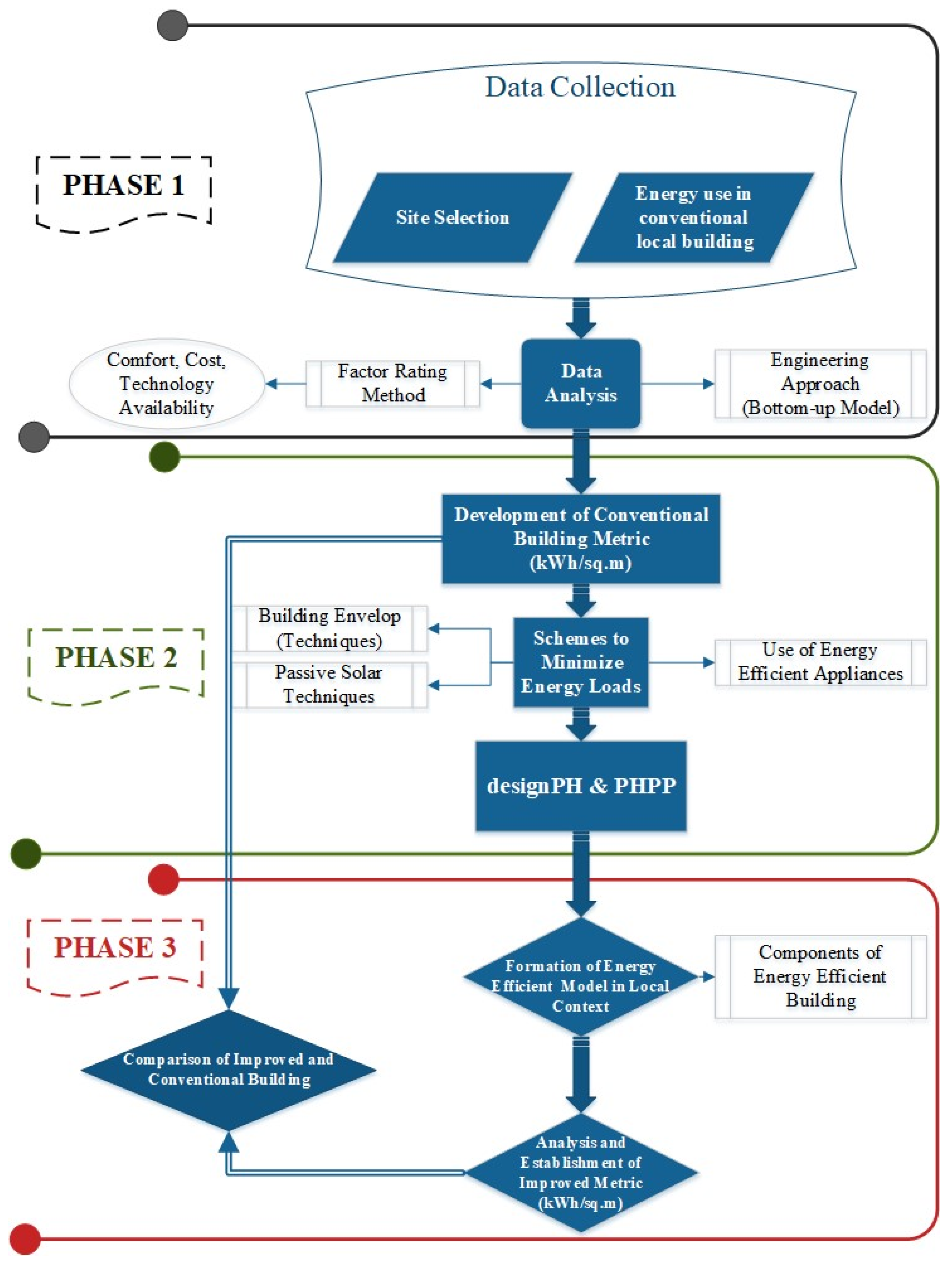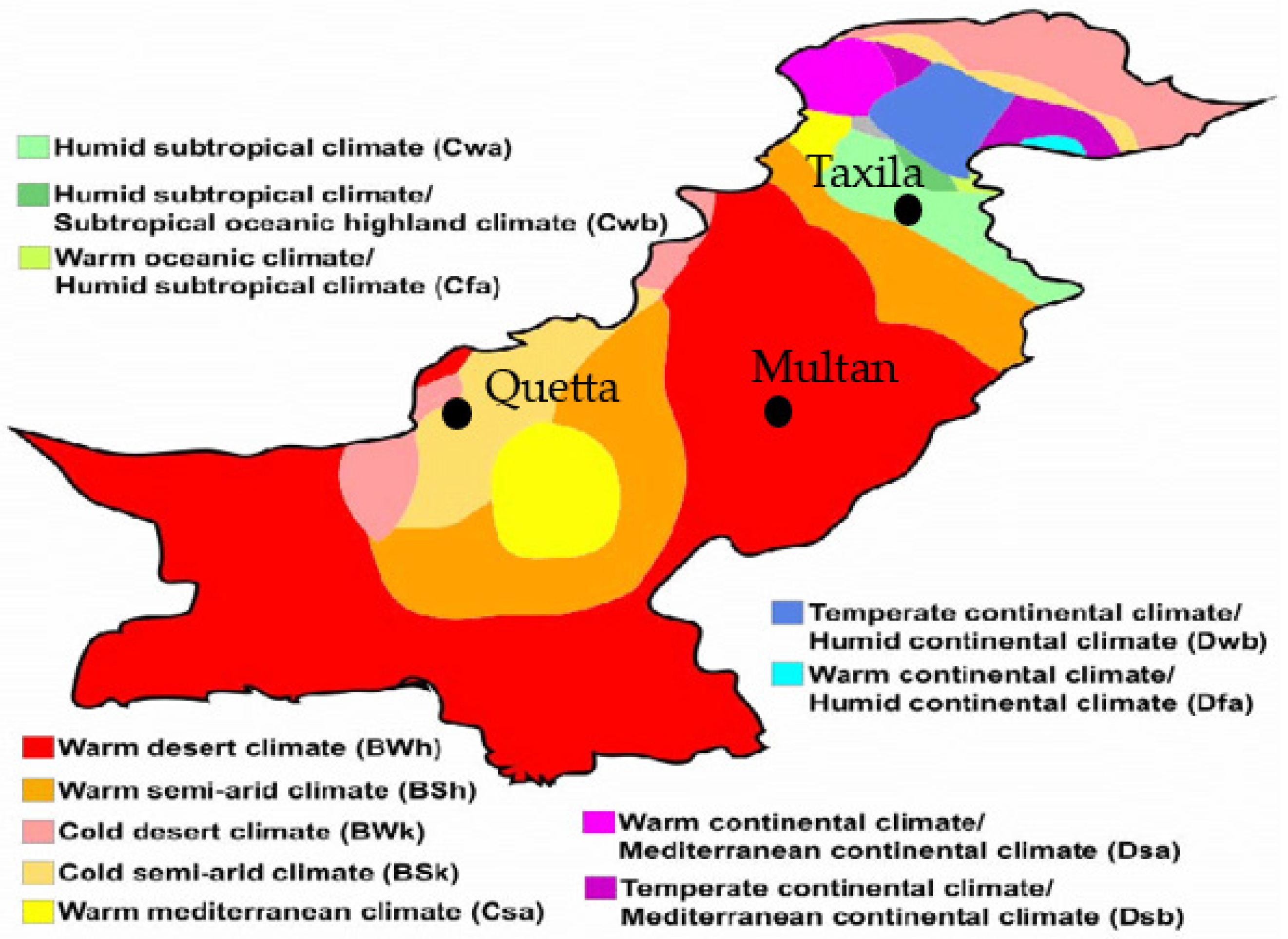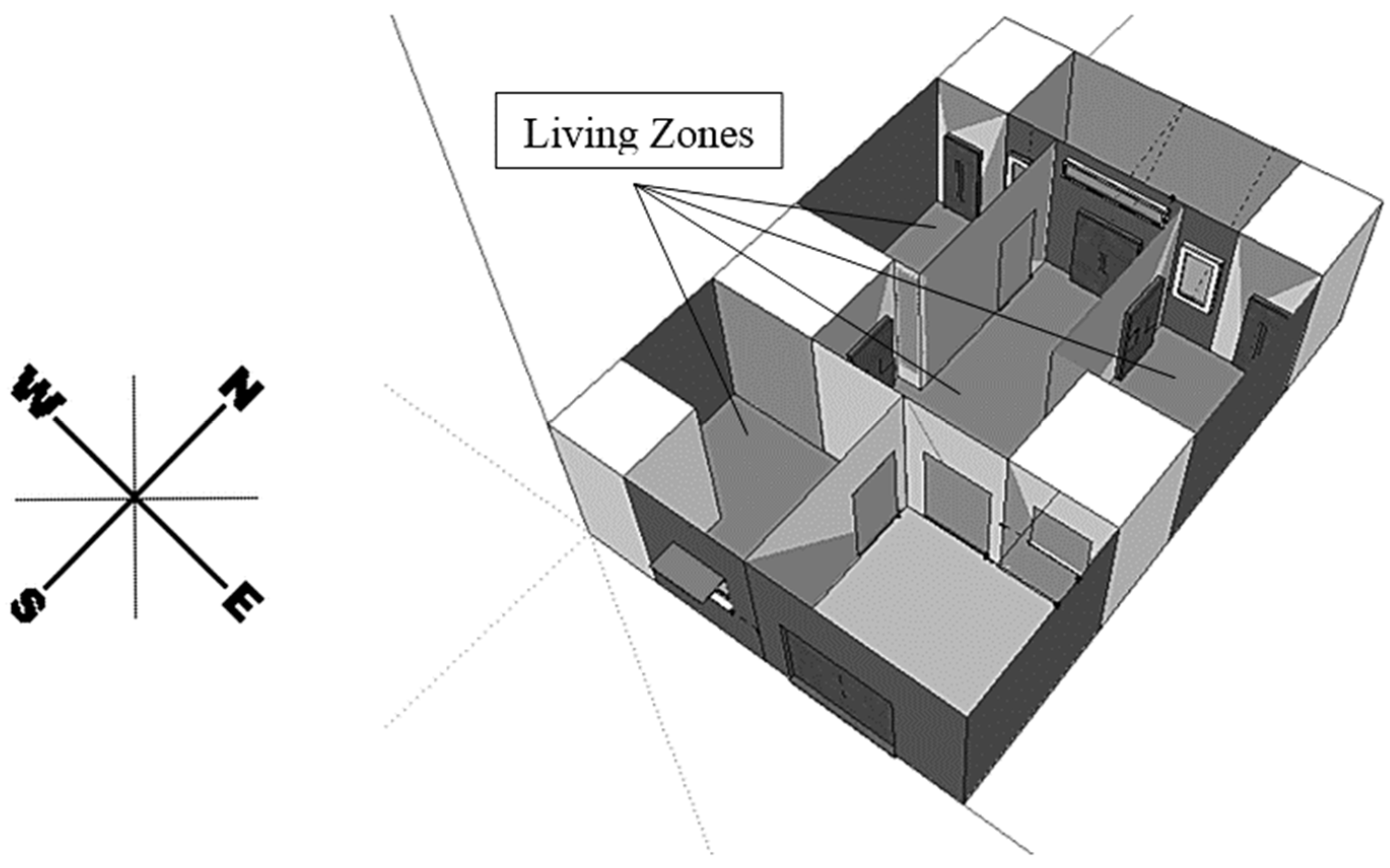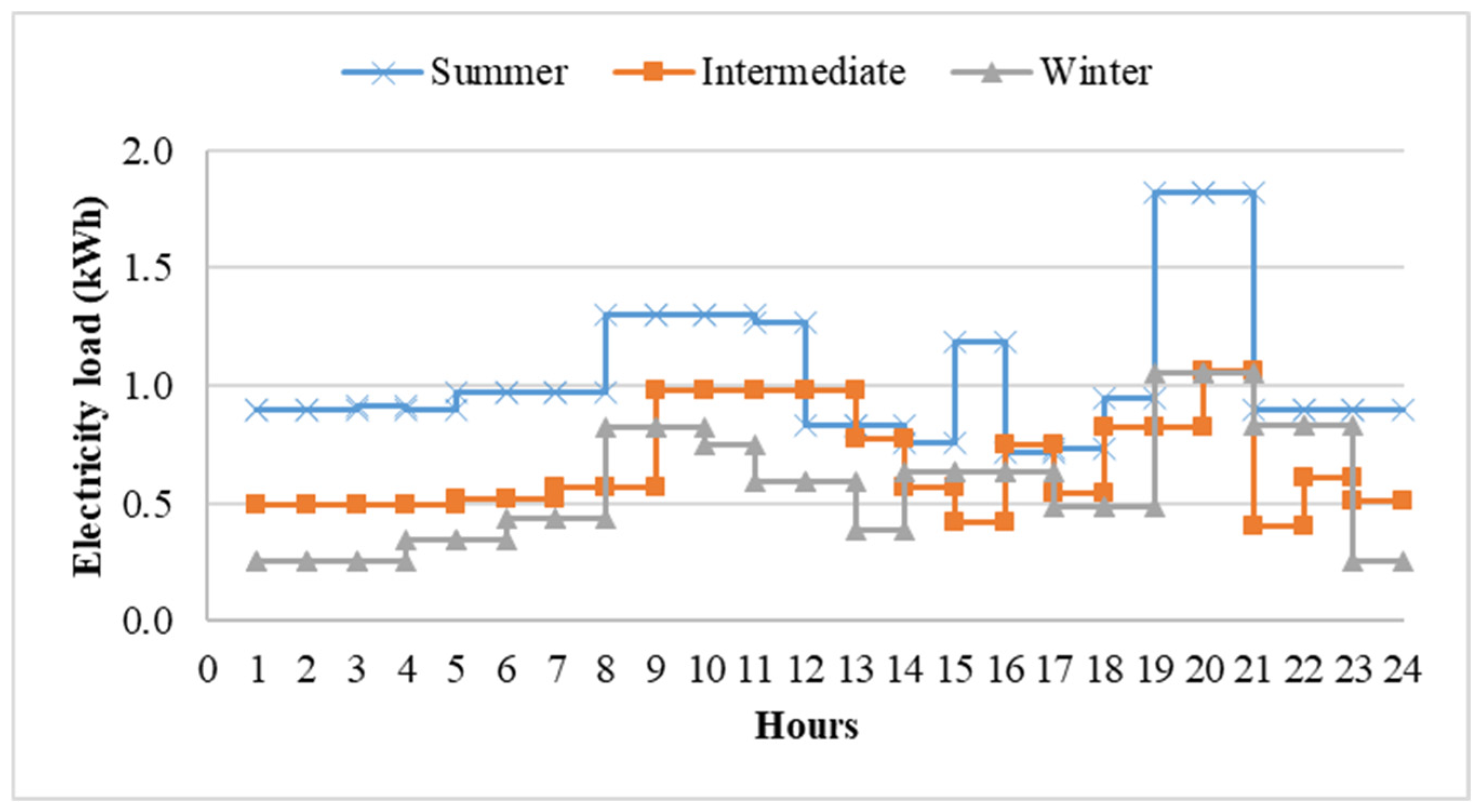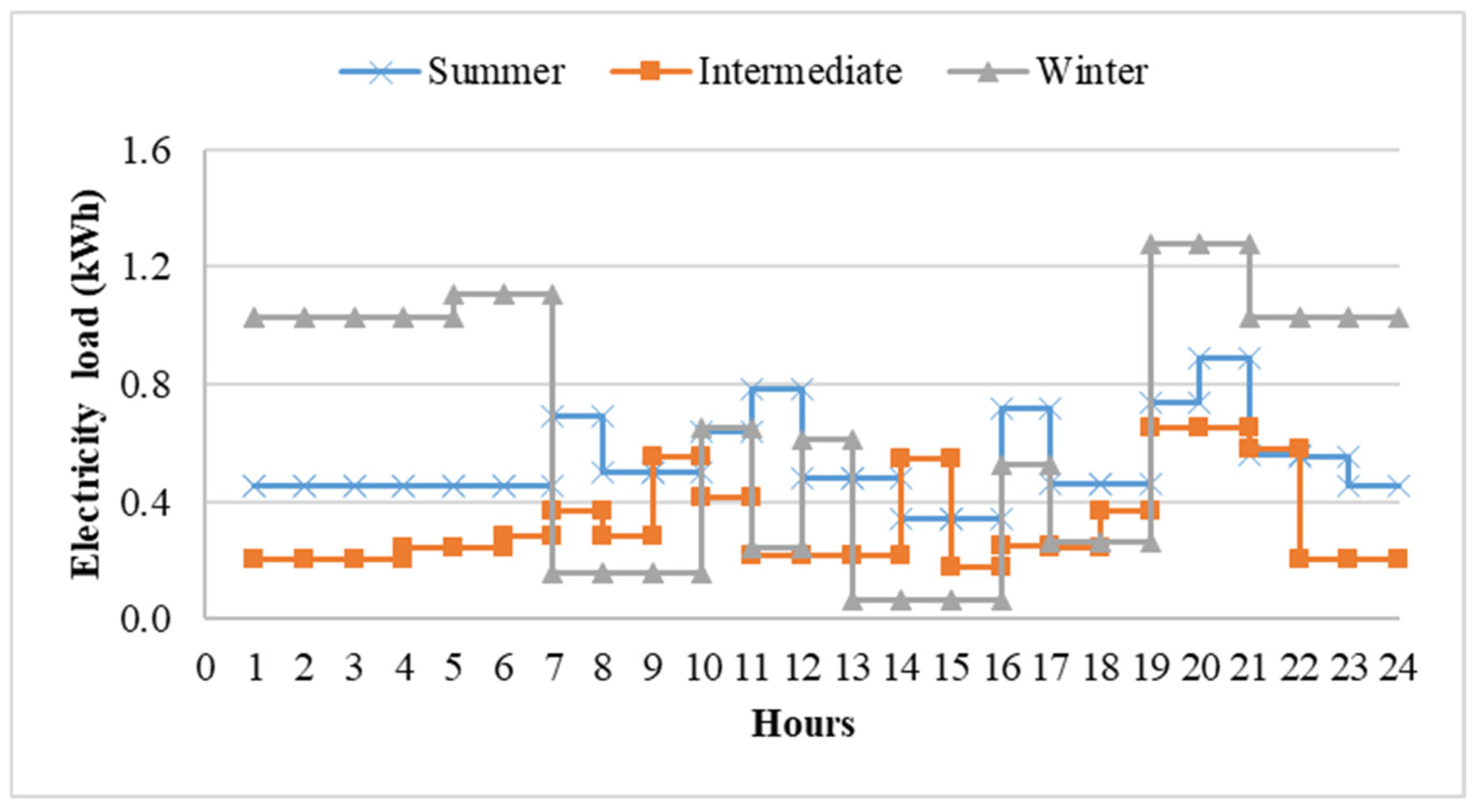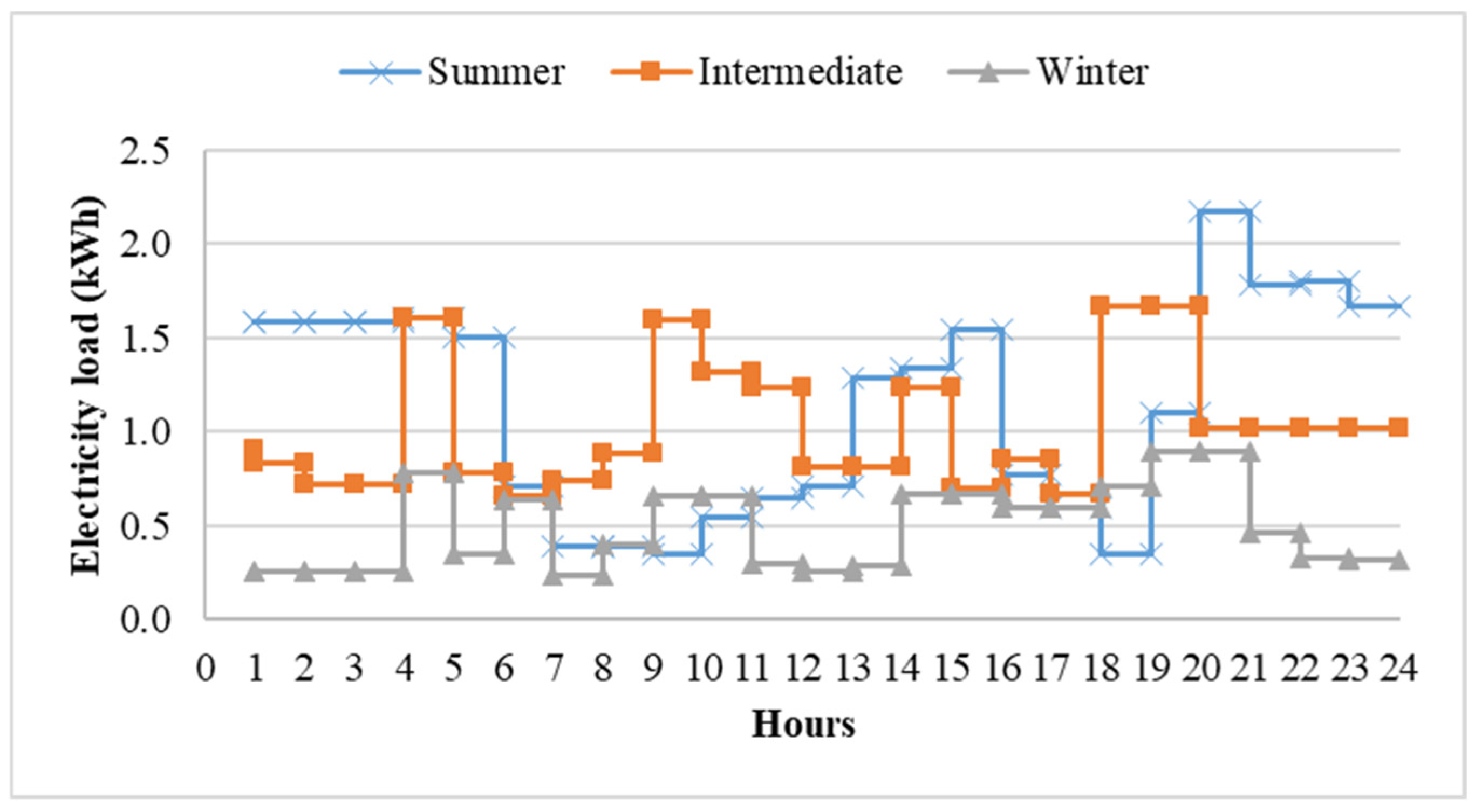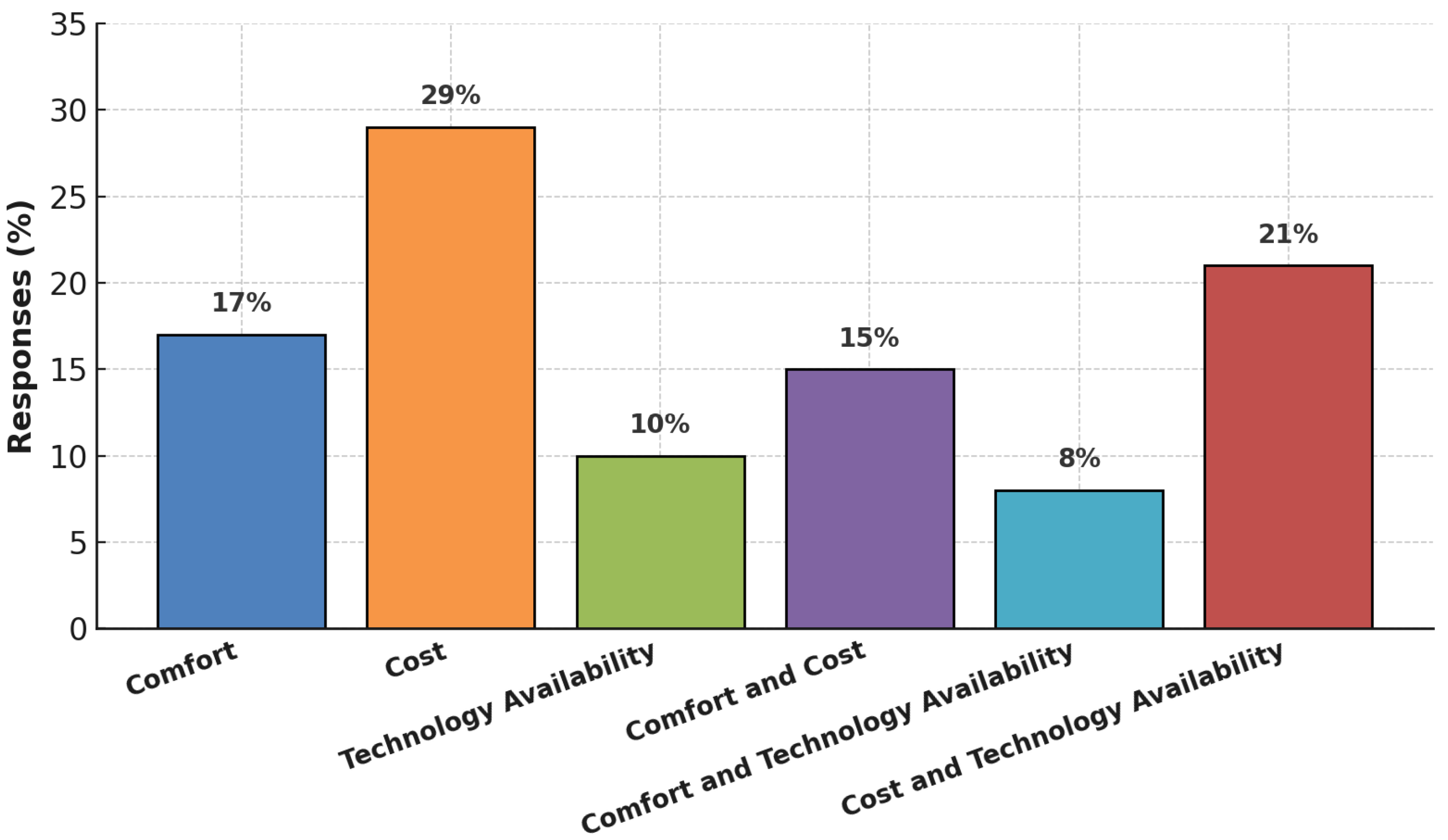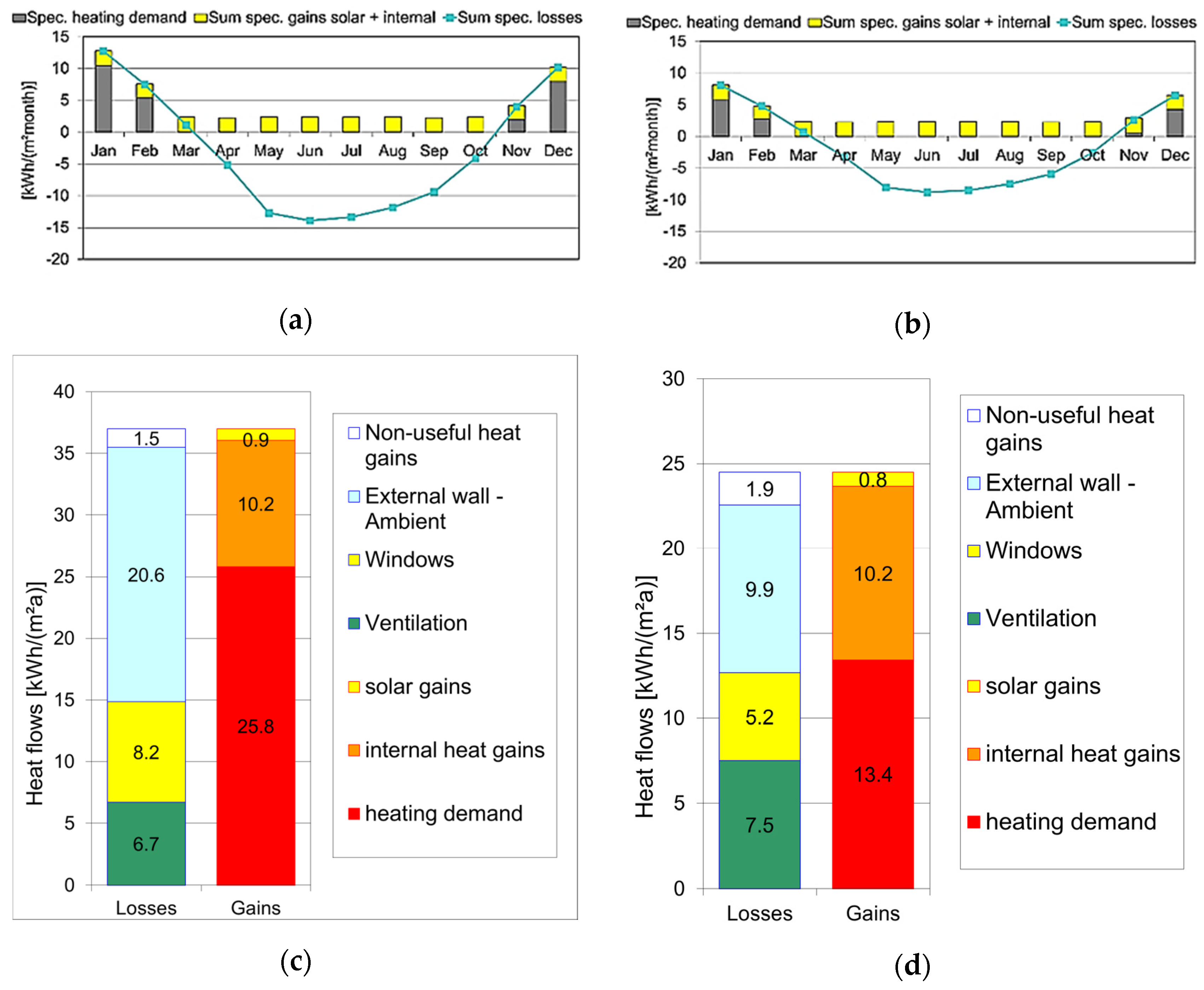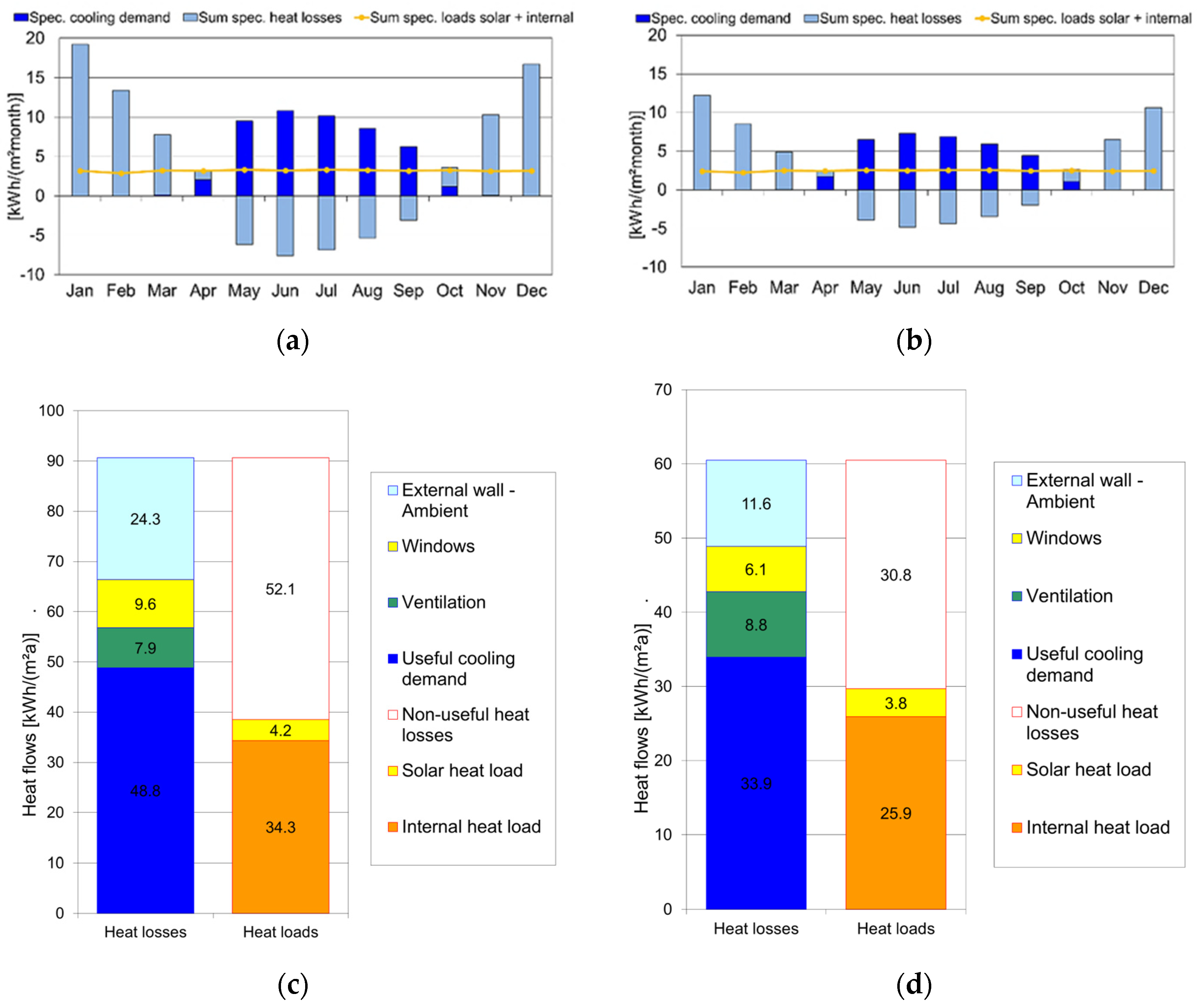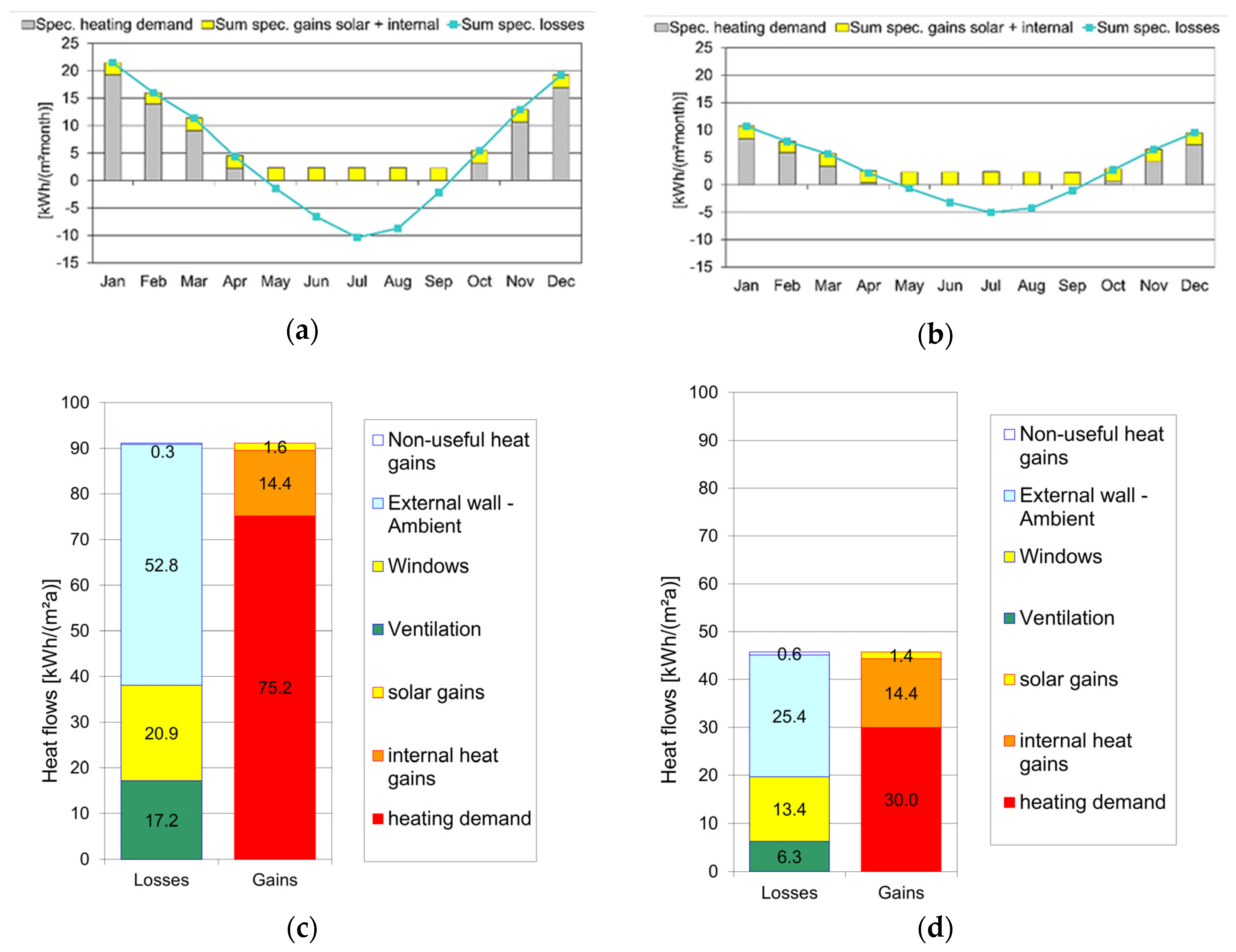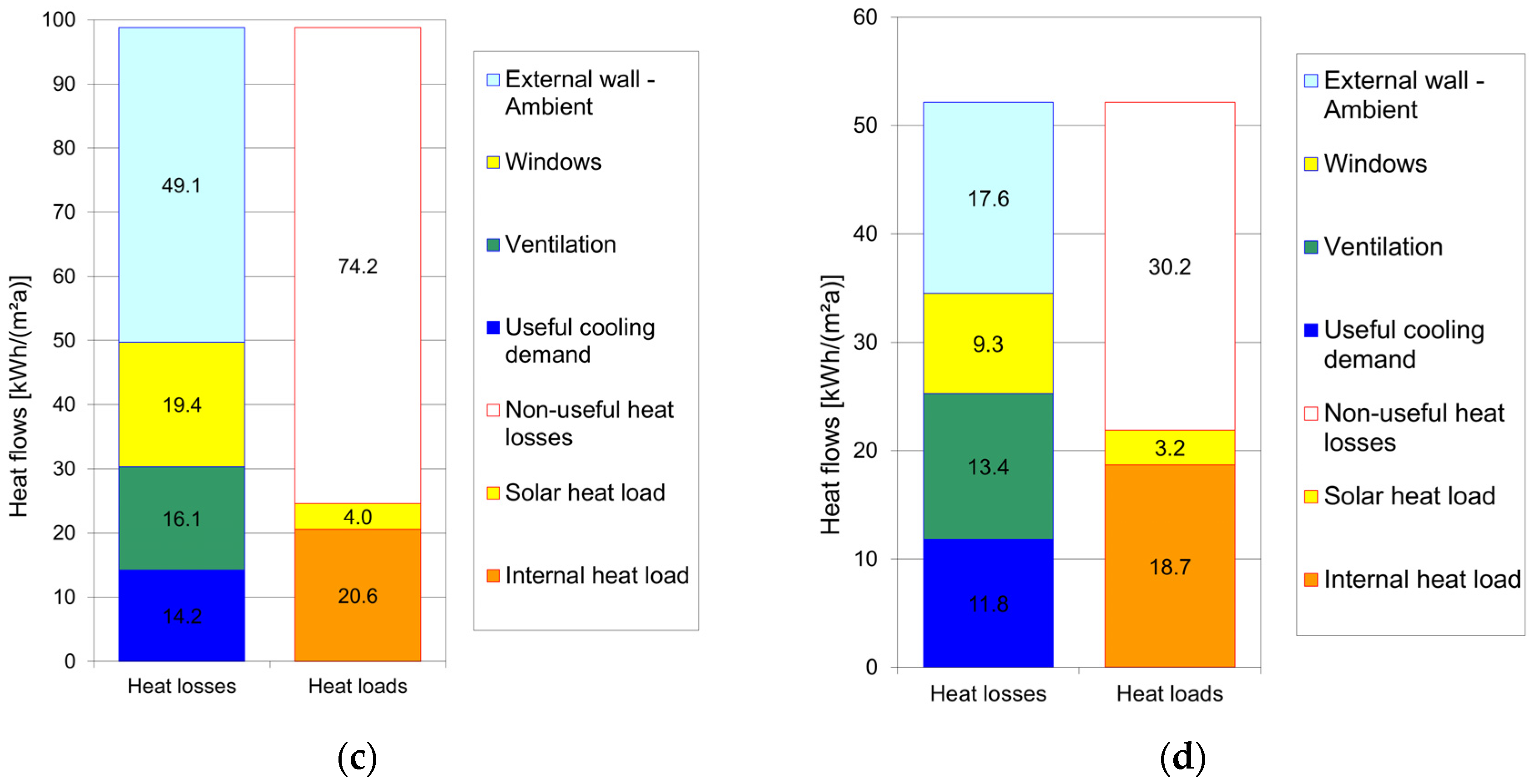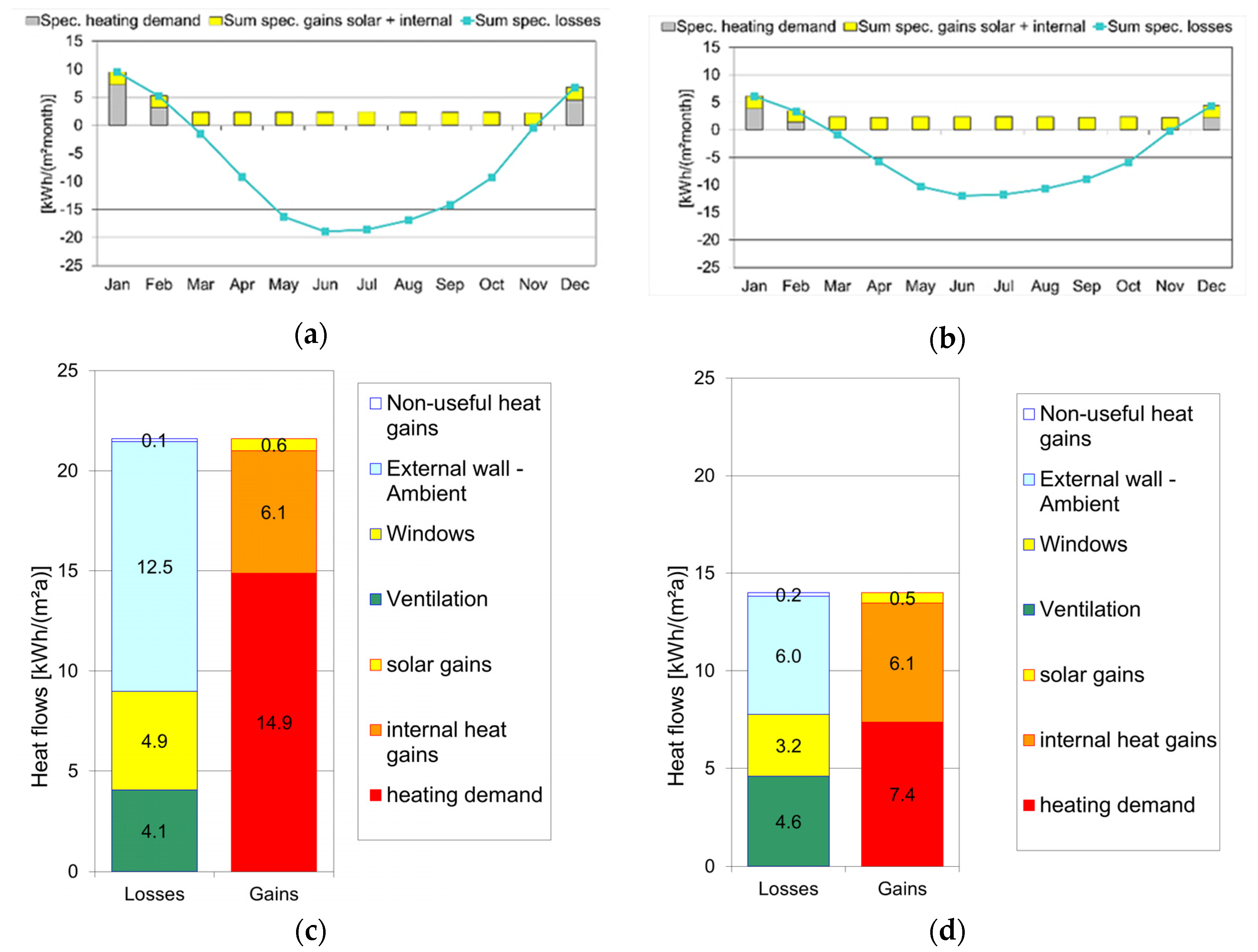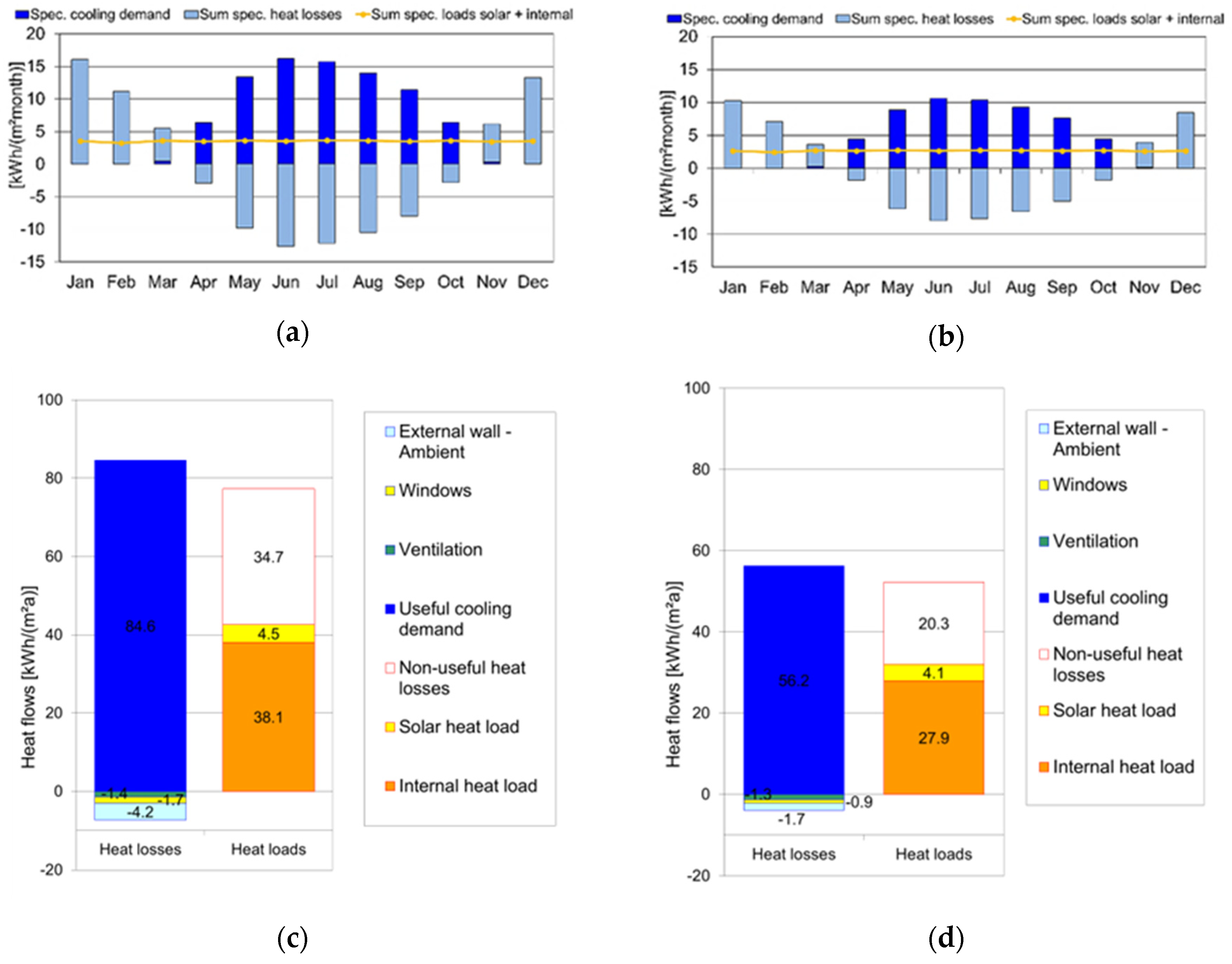1. Introduction
Energy is vital globally, especially for developing countries, in addition to environmental concerns, particularly in developed nations. Inefficiencies in substandard energy-related technologies and methods have intensified the problem in existing energy systems. Energy requirements vary depending on the geography of the area. People’s behavior also influences energy demand. A lack of awareness and misuse of energy result in energy loss, ultimately affecting the country’s economy. Energy demand will likely increase because of population increase, enhanced expectations for everyday comforts, and energy accessibility to low-income people, particularly in developing nations [
1]. Energy utilization in the developing world has rapidly increased in recent decades and is anticipated to grow [
2].
As environmental change turns out to be perceived as the critical ecological issue of the time [
3], the reduction of greenhouse gas emissions has become essential. There exists scientific agreement that improving energy use is vital to mitigating these effects [
4]. One cost-effective solution for addressing this challenge is to implement energy conservation and efficient energy utilization, which can significantly reduce both environmental impact and operational costs [
5]. Historically, this challenge has been handled through technological advancements, such as improving more energy-productive electrical and mechanical equipment. However, effective energy use is not only a technological issue; it is also influenced by human behavior and adherence to established building codes.
The building envelope components [
6] are critical determinants of controlling heat gain, loss, and wind that enters the building. The key elements influencing the performance of a building envelope include materials, construction systems, rooftops, walls, windows, doors, orientation, and shading [
7]. These elements are critical in designing energy-efficient buildings, as they directly affect the energy consumption required for heating and cooling. Glazed areas and shading devices play an essential part in building energy use. Highly glazed facades have been progressively used in new buildings, enabling access to sunshine and outer views. However, the risk of high cooling demand in the building must be considered [
8,
9]. External shading devices for the whole window can restrict 80% of solar radiation falling on the glass surface [
10]. Energy savings in a cooling-dominated atmosphere are generally associated with glazing solutions with a low solar factor and low g-value and U-value, keeping in mind the target of minimizing the cooling load of the building [
11]. On the other hand, in a heating-dominated climate, a high solar factor is suggested, particularly in circumstances where the building architecture is utilized for passive heating [
12]. A high solar factor permits a greater passive solar heat gain. Windows are considered one of the most critical elements of the building envelope in terms of energy use and comfort. Depending on their properties, exterior window shadings and glazing can significantly impact the indoor air conditioning of the buildings by deciding the direct solar gain [
13,
14,
15].
Internationally, various building energy codes have been developed to set energy efficiency standards for buildings. Particularly, the American Society of Heating, Refrigerating, and Air-Conditioning Engineers (ASHRAE) standard [
16] provides comprehensive guidelines for energy-efficient design in commercial and residential structures. This standard encompasses various aspects, including building envelopes, heating, ventilation, and air conditioning (HVAC) systems, lighting, and service water heating, aiming to reduce energy consumption and greenhouse gas emissions in the building sector. The International Energy Conservation Code (IECC) [
17], developed by the International Code Council (ICC), establishes minimum requirements for energy-efficient buildings using both prescriptive and performance-related provisions, addressing aspects like insulation, air leakage, HVAC systems, and lighting. Passive house standard [
18] is one of the international standards which focuses on providing comfortable indoor conditions with extremely low heating and cooling loads. The peak daily average heating and cooling loads are commonly below 10 W/m
2, and yearly valuable energy demands are below 15 kWh/m
2. The window type, protection levels, and mechanical services rely on the climate and the building’s shape and orientation. The subsequent yearly energy demand for space conditioning of the passive houses is 75 to 95% lower than that of a customarily insulated building of the same geometry [
19].
In Pakistan, the Energy Conservation Building Code (ECBC)–2023 [
20] outlines minimum energy performance standards for residential buildings but has limited application of climate-based detailed energy-efficient design principles (c.f.
Table 1). The code provides a generic range of techniques, including thermal insulation, energy-efficient windows, and building orientation. However, it does not provide comprehensive performance standards for different climates, as in other internationally adopted building energy standards. International codes such as ASHRAE and the IECC have proven effective in reducing energy consumption and operating costs in buildings. These codes emphasize comprehensive energy management, including design practices that reduce heating and cooling loads and improve energy efficiency across all building systems. As a result, buildings built according to these codes can achieve energy savings of up to 30% or more compared to conventional construction [
21]. In comparison, the ECBC-2023 provides the necessary framework for improving building energy use in Pakistan, but it is still in the early stages of adoption. Nevertheless, ECB-2023 offers a step toward improving the energy performance of buildings in Pakistan, focusing on minimizing heat flows across the building envelope. The code’s passive design techniques, such as improved insulation and optimized shading, reduce the demand for space conditioning and improve indoor comfort.
Pakistan’s energy sector faces numerous challenges, from supply-side crisis management to limited efforts on the demand side to address energy inefficiency [
22]. Energy security and affordability are key factors in achieving sustainable building energy use in developing countries like Pakistan [
23]. The country’s growing population and increasing number of single-family houses contribute to rising energy demands. Pakistan’s electricity demand has grown exponentially and can only be controlled through energy savings at each level. In 2020–2021, residential energy consumption accounted for 20.98% of total energy use, excluding non-commercial energy resources, in Pakistan, with electricity consumption representing approximately 50% of this share [
24]. The building sector, particularly residential buildings, contributes significantly to these demands due to inefficient building designs.
Despite the introduction of ECBC-2023 as a structured guideline to reduce energy demand in Pakistan’s building sector, there is currently no quantitative study evaluating its effectiveness in the residential domain across diverse climatic zones. Previous studies have largely focused on isolated passive strategies or generic energy-saving measures without offering a holistic assessment of code-compliant retrofits grounded in current national standards. Moreover, the potential economic and environmental implications of ECBC-compliant retrofits, such as cost-effectiveness, carbon footprint reduction, and long-term viability, have not been comprehensively investigated in the context of Pakistan’s local construction practices and climatic diversity.
This study addresses these gaps by evaluating the energy, economic, and environmental performance of ECBC-2023-compliant residential building retrofits through simulation-based analysis using the Passive House Planning Package (PHPP 9.3) [
25], a validated energy modeling tool. The analysis incorporates real-world field data collected from three climatically distinct cities, Multan (hot desert), Taxila (humid subtropical), and Quetta (cold semi-arid), to simulate both conventional and energy-efficient scenarios. In addition to assessing the impact on heating and cooling loads, the study includes life cycle economic evaluation and carbon emissions analysis to provide a more comprehensive understanding of retrofit effectiveness.
The objectives of this study are defined as follows:
To quantify the energy savings achieved through ECBC-compliant retrofits in residential buildings across different climates in Pakistan.
To evaluate the economic feasibility of these interventions through Net Present Value (NPV) and payback period analysis under varied economic parameters.
To assess the overall environmental benefit through a life cycle emissions analysis incorporating both operational and embodied carbon.
This study contributes toward bridging the gap between policy and implementation by offering quantitative evidence to support the refinement of ECBC guidelines, enabling region-specific adaptation strategies, and informing policy measures aimed at advancing energy-efficient residential development in Pakistan.
2. Materials and Methods
Energy consumption of residential buildings depends upon multidimensional parameters. Therefore, a methodology was established by considering all factors that influence the energy consumption of residential buildings, and a practical solution to this problem was provided sequentially. This research started with a technical feasibility analysis of an ECBC-compliant household. This was followed by an economic evaluation and sensitivity analysis of different economic parameters. Finally, the life cycle assessment (LCA) was conducted to evaluate the environmental impact of the building retrofits. The technical feasibility study was divided into three phases, as shown in
Figure 1.
Phase 1 (Field Study)
First, a field survey was conducted for different geographic locations in Pakistan to obtain base data. While conducting the study, three climate zones were selected to represent the country’s climatic diversity, and energy consumption in conventional local buildings for each climate zone was calculated. According to the climate classification of Pakistan [
26] or Köppen–Geiger climate classification (c.f.
Figure 2) [
27], climate zone B or humid subtropical (Taxila), climate zone C or cold semi-arid (Quetta), and climate zone D or hot desert (Multan) were selected for this study. These zones cover a wide range of thermal conditions, including hot-dry summers, cold winters, and mixed climates, which allowed for a comprehensive assessment of the retrofit strategies under varying energy demand profiles. Zone B and C are characterized by mild cold winters and cold winters with hot summers, respectively. Whereas zone D represents the hottest and dry region of Pakistan. The seasonal variations are different for each zone, such that the summer and winter characterize the months having prominent cooling and heating demands, respectively. However, there are months with minimal heating or cooling demands in each zone, which are categorized as intermediate season. The summer season occurs from May to September in Taxila and Quetta and from May to October in Multan. The winter season occurs from December to February in Taxila and Multan and from November to February in Quetta. The remaining months fall in the intermediate season.
The data was collected in the form of energy bills for historical energy consumption of the building and calibrated according to appliances, operation time, building area, building material, climate conditions, etc., to identify energy conservation opportunities.
Phase 2 (Existing Building Energy Metric)
In this phase, an energy metric (kWh/m2) was calculated to measure the energy consumed by a conventional local building. Energy-saving opportunities in buildings were also identified. The possible energy efficiency measures were using energy efficiency appliances and building envelope improvements. Building envelope techniques include orientation, wall type, wall material, and insulation of walls. Window types, like single and double pane, and window glazing were also considered for retrofitting. Google SketchUp was used to design the building structure, and designPH and PHPP tools were used to analyze energy load.
Phase 3 (Passive House Energy Metric)
The energy efficiency metric in the local context was developed in the third phase by considering the building components given in the second phase. This phase explained the establishment of improved energy metrics (kWh/m2) and their comparison with the energy metrics of conventional buildings in terms of energy consumption and economics. The cost of building retrofits was calculated to check the economic feasibility of the design. Capital, replacement, and operation costs were considered when computing payback periods and NPV.
2.1. Design PH and PHPP Tool
The building architecture was built in Google SketchUp 2020. The dwellings included four living zones, two baths, and a car porch with a total area of 125 square meters. The designPH plugin was installed in Google SketchUp to work with building elements such as walls, shading, roofs, etc. These elements were defined in terms of dimensions and material. The zones of heating/cooling requirements were also identified in the designPH model. Once the designPH building model was imported into PHPP, climate data and electricity profiles, calculated from field surveys, were provided in the PHPP tool for all climate zones. Heating and cooling loads per sq. meter for conventional building models were calculated monthly and annually. Building elements like insulation of walls and roofs, orientation, shading, and windows were redefined in designPH, and the same practice was followed in PHPP to generate results.
The PHPP tool was selected over other simulation tools due to its relatively simplified data input requirements, suitability for envelope-focused energy retrofitting, and direct compatibility with the SketchUp-based designPH plugin. It provides a practical solution for early-stage design and compliance evaluations, particularly where detailed HVAC specifications and dynamic schedules are not the primary focus. Moreover, PHPP has been widely used in both residential and small-scale commercial retrofit projects, particularly in Europe and South Asia, owing to its transparent calculation method and suitability for steady-state analysis. Importantly, PHPP has been validated against the International Standardization Organization (ISO) Standard 13,790 and ANSI/ASHRAE Standard 140–2017. PHPP has been independently validated under ASHRAE Standard 140, where its simulation outputs for heating and cooling demands fell within a ±5% tolerance band, using a 93% confidence interval. This validation confirms the statistical robustness of PHPP’s predictive results, further supporting the reliability of simulation-based savings reported in this study [
29].
2.2. Calculation of Heating/Cooling Demand
The PHPP tool used for building energy analysis included all parameters affecting the heating or cooling demand of the building. The energy balance of the envelope is shown in the following Equation (1). A negative energy balance output indicates cooling demand, and a positive value indicates heating demand.
Transmission Heat Losses
QTAnnual heat losses were calculated for the whole building envelope (window, walls, and roof) using the formula in the following equation.
where
A is the area of the building element,
U is the U-value of the building element,
fT is the reduction factor for the reduced temperature difference, and
Gt is the temperature difference time integral (heating/cooling degree hours).
Ventilation Heat Losses QV
Ventilation heat losses were calculated using the following equation:
where
VV is the volume of the ventilation system,
nv is the effective air exchange rate, and
c is the specific heat capacity of air.
Internal Heat Gains Qi
Internal heat gains included heat produced by occupants and electrical appliances during the heating/cooling.
where
h is the heating/cooling period,
is the specific power, and
ATFA is the treated floor area.
Solar Radiation Heat Gains QS
The solar heat gain of the building was calculated as follows:
where
r is the reduction factor,
g is the total solar energy transmission coefficient,
AW is the window area, and
G is the total solar radiation.
The net building thermal load in PHPP was calculated by applying the above relations for the investigated household model. The modifications in the envelope were applied in designPH, and then the same relations were used in the PHPP tool for load calculations of retrofitted low-energy consumption buildings.
2.3. Data Analysis
The field survey was conducted for three different climate zones, hot, mild, and cold, in different geographic locations in Pakistan, to obtain baseline data. A total of 127 households were surveyed across Taxila, Quetta, and Multan, representing a variety of construction types, socioeconomic levels, and access to energy resources. From this larger dataset, a subset of ten households per location—selected for their approximately similar floor areas, electricity access, and income levels—was used for detailed building energy simulations.
The survey considered a range of parameters, including the geographic area of each building, occupancy patterns, estimated energy usage, building envelope characteristics, orientation, and the presence of lighting, cooling, and heating systems. Additionally, the questionnaire included social and behavioral dimensions to better understand local traditions and cultural attitudes toward energy use. Electricity consumption in existing residential buildings was assessed using daily, monthly, and annual patterns. Subsequently, electricity profiles were generated for the selected locations. Data was analyzed using the engineering model (bottom-up model) and the factor rating method. The factor rating method leveraged the full dataset of 127 surveyed households, ensuring that the diversity in occupant behavior and priorities was reflected in the assessment. It prioritized energy consumption indicators, i.e., comfort, cost, and technology availability.
2.3.1. Building Envelope
This study focused on the effect of building orientation, envelope insulation, window glazing, and window shading. The effect of these parameters was analyzed on annual space heating and cooling demand. Four living zones of a typical horizontal roof residential building architecture in Pakistan, as shown in
Figure 3, were analyzed for energy demand for heating or cooling. Building parameters, zone area, treated floor area, and total area of buildings are defined from the field survey, as given in
Table 2.
The design modifications applied in this study are described in
Table 3 and
Table 4. Initially, the energy demand for building was calculated for all four orientations, i.e., building facing South, North, East, and West. The best orientation was south-facing, as evident from
Table 3, and the same was used in improved architecture. Other retrofits performed were building envelope insulation, window glazing, and window shading.
The ECBC-2023 of Pakistan recommends that the U-value of the wall and roof should not exceed 0.57 and 0.44 W/m
2K, respectively. However, U-values of 0.33 and 0.28 are recommended for horizontal roofs across different climates [
20]. The U-value of 0.33 W/m
2K was used for walls in this study for three climates.
2.3.2. Electricity Load Profile
Humid Subtropical Climate—Taxila
Figure 4 represents a household’s daily average electricity consumption for three seasons in the humid subtropical climate of Taxila. Peak loads were lower than those of Multan in Taxila for all seasons. Summer climate peak value was reduced to 1.8 kWh
e from 7:00 PM to 9:00 PM. The peak load in the intermediate season was from 7:00 PM to 9:00 PM, and its value was 1.1 kWh
e. There was little difference in winter and intermediate season peak loads due to low cooling demand in the intermediate season. So, the peak value of electricity consumption in the winter was 1.0 kWh
e from 7:00 PM to 9:00 PM. Maximum electricity consumption was in summer, 747 kWh
e/month, then in the intermediate season with a value of 491 kWh
e/month, and minimum in winter with 416 kWh
e/month.
Cold Semi-Arid Climate—Quetta
Daily average electricity consumption profiles for the same household design in a cold semi-arid region are given in
Figure 5. The electricity consumption in the summer is low, whereas it is maximum in winter. The reason behind this change is the high demand for heating in winter and the low demand for cooling in summer. Another factor is the long winter season and short summer season in Quetta. The peak load was 0.9 kWh
e from 8:00 PM to 9:00 PM and 0.7 kWh
e in the intermediate season from 7:00 PM to 9:00 PM. In the winter, the peak load value reached 1.3 kWh
e from 7:00 PM to 9:00 PM. Monthly electricity consumption was maximum in winter, with an average value of 501 kWh
e. This value was 383 kWh
e in the summer and 239 kWh
e in the intermediate season.
Hot Desert Climate—Multan
Figure 6 provides the typical daily average electricity consumed by a household in a hot region during the summer, intermediate, and winter seasons. The load curves showed that electricity consumption was highest in the summer season. Summer season peak load was 2.2 kWh
e from 8:00 PM to 9:00 PM. For the intermediate season, it was 1.7 kWh
e from 6:00 PM to 8:00 PM. In comparison, peak value in winter occurred from 7:00 PM to 9:00 PM, i.e., 0.8 kWh
e. Monthly electricity consumption was 828 kWh
e, 759 kWh
e, and 362 kWh
e in the summer, intermediate, and winter, respectively.
2.3.3. Factor Rating Method
Figure 7 illustrates responses to cost, comfort, technology availability, and combinations of these three factors. The cost was the top priority of building owners, and it had the precedence of 29%. Likewise, “cost and technology availability” was considered the second most crucial factor, prioritized by 21% of respondents. Then comfort was given third importance, having a share of 17%. Comfort with cost and technology availability were on the lower side of the priorities list. “Comfort and technology availability” was considered the least concern, at 8%. Consequently, low-cost technology was a primary demand for the targeted income class. It was also derived that people did not positively respond to an expensive technology that could provide high comfort.
3. Results
The annual energy balance of the house was calculated using the PHPP tool for existing and efficient buildings. The heating or cooling demand was also calculated per square meter per annum. The annual energy balance and monthly heating/cooling demand, along with the internal gains for each city, are demonstrated in this section. The heating or cooling demand of the building was controlled by restricting the heat flow from or into the building using insulation material on walls and changing the window material. The results showed that envelope retrofitting effectively reduced building thermal load in winter and summer for all climate zones.
3.1. Humid Subtropical Climate—Taxila
Figure 8a–d show monthly heating demand and annual space heating energy balance in this climate zone for conventional and modified building design. The effect of envelope modification was a decrease in building heat losses, resulting in lower heating demand. Maximum space heating demand in January was reduced to 5.8 kWh/m
2 in the retrofitted building, which was 10 kWh/m
2 in the conventional design. Annual heat losses from the building were 37 kWh/m
2 and reduced to 24.5 kWh/m
2 after envelope modifications, resulting in a low heating demand of only 13.4 kWh/m
2. Heat losses from windows and walls were reduced by 36% and 51%, respectively.
The effect of envelope retrofits on the space cooling demand of residential buildings is shown in
Figure 9.
Figure 9a,b demonstrate that the new building envelope significantly reduced monthly space cooling demand. The cooling period in Taxila was longer than the heating period, which comprised 07 months. Maximum cooling demand was in June, which was initially 12.5 kWh/m
2 and was reduced to 7.5 kWh/m
2 by envelope retrofits. The annual space cooling energy balance shows that the new building envelope effectively restricted heat flow from outdoors to inside the building, as illustrated in
Figure 9c,d. The heat load through the envelope decreased from 50.1 to 30.8 kWh/m
2.a. Heat flow from external walls decreased by 52%, and solar heat gain decreased by 10%. This phenomenon reduced the annual space cooling load from 48.8 kWh/m
2 to 33.9 kWh/m
2.
3.2. Cold Semi-Arid Climate—Quetta
Quetta’s ambient conditions were different from those of the other two locations. The outdoor temperature was lowest of the three zones. Therefore, the primary concern in Quetta was space heating. Space heating demand in Quetta was required for 07 months, Jan to April and Oct to Dec. The space heating load was 19 kWh/m
2 in Jan and remained higher than 10 kWh/m
2 for 04 months. However, envelope retrofits effectively controlled heating demand, and heat flow from inside to outdoors decreased substantially in the new design. Thus, the maximum space heating demand in Jan was reduced to 8.3 kWh/m
2, as shown in
Figure 10a,b. The annual space heating energy balance of Quetta, as shown in
Figure 10c,d, depicts that heat losses from walls and windows were reduced by 51% and 35%, respectively, through envelope modifications. In the new building envelope, total annual space heating demand was also significantly decreased, from 75.2 kWh/m
2 to 30 kWh/m
2.
The space cooling period in Quetta was only three months, from June to August. The maximum cooling demand was in July, having values of 5.9 kWh/m
2 and 5 kWh/m
2 for conventional and retrofitted building designs, respectively, as shown in
Figure 11a,b. It remained below 5 kWh/m
2 in the other two months for both building designs. The annual energy balance of space cooling for conventional and retrofitted building designs in Quetta is given in
Figure 11c,d. These figures show that the heat gain through the envelope decreased from 74.2 kWh/m
2 to 30.2 kWh/m
2 after retrofits, but its effect on total cooling demand is not very prominent. The annual space cooling demand was 14.2 kWh/m
2 in the conventional building and 11.8 kWh/m
2 in the retrofitted building.
3.3. Hot Desert Climate—Multan
The residential building load for the same design features of the envelope was calculated in Multan, where the outdoor temperature was higher than in Taxila.
Figure 12 shows the monthly heating demand in Multan and the annual space heating energy balance for conventional and retrofitted envelope buildings. Space heating was required for 03 months, whereas this period was 05 months in Taxila. Specific heat losses were above the datum line for Jan, Feb, and Dec only, as depicted in
Figure 12a,b. In conventional design, the maximum heating demand was 7.4 kWh/m
2 in January, which was reduced to 3.9 kWh/m
2 through envelope retrofits. Heat losses from external walls and windows also decreased significantly, as shown in
Figure 11c,d, 52% and 34%, respectively. Therefore, annual space heating demand in Multan remained at 14.9 kWh/m
2 for conventional building design and 7.4 kWh/m
2 for retrofitted envelope design.
Space cooling demand in Multan for both building envelope features is given in
Figure 13. Space cooling was required from April to October, with minimal cooling demand in March and November. The maximum cooling demand was in June, and its value was 16 kWh/m
2 and 11 kWh/m
2 for conventional and modified building envelopes, respectively. Cooling demand for conventional building design was higher than 10 kWh/m
2 from May to Sep. In contrast, it exceeded 10 kWh/m
2 in June and July only for the retrofitted envelope. The annual space cooling energy balance of both building designs is given in
Figure 13c,d. Heat flow from outdoor to inside was reduced from 34.7 kWh/m
2 to 20.3 kWh/m
2, and there was a 26% decrease in internal heat loads by envelope modifications. The annual space cooling demand was 84.6 kWh/m
2 in conventional design, and it was reduced to 56.2 kWh/m
2 in retrofitted building design.
3.4. Energy Balance Comparison of Building Designs
A comparison of energy balance between conventional building design and efficient building design is given in
Table 5. It shows that heat outflows from buildings decreased significantly during heating, resulting in lower heating demand. The energy savings during the heating period in Taxila, Multan, and Quetta were 48%, 50%, and 60%, respectively.
The modifications in the building design were equally effective during the cooling period. The energy-saving potential during summer in Taxila, Multan, and Quetta was 44%, 33%, and 16%, respectively. Maximum heat losses or gains were through external walls, which were significantly restricted after building retrofits. It was observed that envelope retrofits were very effective, and energy conservation was significant across all climate conditions. Either cooling or heating demand was higher; envelope modifications greatly impacted air conditioning demand.
3.5. Economic Analysis
Economic analysis of the efficient buildings for three different climate zones is shown in
Table 6. The roof area of the building is 125 m
2, and the external wall area of the building is 138.5 m
2. The insulation cost for the total area of the building was USD 464. The cost of window glazing and shading was USD 282. The total cost of retrofits was estimated to be USD 746 in this study, and it was considered the same in all locations. However, the energy-saving potential and associated benefits differed due to varying ambient conditions.
In the mild climate zone of Taxila, energy saving in summer was 1025 kWh and 851 kWh in winter. For the hot climate zone in Multan, energy savings of 1950 kWh and 517 kWh were attained in summer and winter, respectively. Summer energy savings were 165 kWh and 3111 kWh in winter in Quetta. The average COP of the heat pumps was assumed to be 2.5 for all locations. According to the monthly average electricity consumption, the average electricity tariffs were 0.13 USD/kWh in Taxila and Multan and 0.12 USD/kWh in Quetta. Further, the total electricity saved was 750 kWhe/annum in Taxila, 987 kWhe/annum in Multan, and 1310 kWhe/annum in Quetta. Consequently, the highest benefit of USD 152 was achieved in Quetta, USD 129 in Multan, and USD 94 in Taxila. The economic indicators used in this study were simple payback period (SPP), NPV, and discounted payback period (DPP), keeping the discount rate fixed at 5% for a life cycle of 30 years. The building retrofits were economically more feasible in the cold semi-arid climate zone with an NPV of USD 1670 and a discounted payback of 6 years. NPV was reduced to USD 1226, and the discounted payback period increased to 8 years in Multan, a hot desert climate. Taxila, a humid subtropical climate zone, had the largest discounted payback period of 10 years and the lowest NPV of USD 752.
To assess the robustness of retrofit economics under varying conditions, a sensitivity analysis was performed considering changes in key financial parameters. These included variations in discount rate (5%, 10%, and 15%), electricity tariff (±5%, ±10%), and retrofit cost (±20%). The results, summarized in
Table 7, reveal that all three indicators (NPV, SPP, and DPP) were significantly influenced by these factors. For instance, under base-case conditions, the payback period ranged between 4.7 and 7.7 years across the three locations. Increasing the electricity tariff by 10% reduced the discounted payback period to 5–8 years, while a 20% increase in retrofit cost extended it to 8–13 years.
3.6. Life Cycle Assessment
In addition to operational energy analysis, a life cycle assessment (LCA) was performed to evaluate the long-term carbon impact of retrofit interventions. The assessment considered both embodied emissions from major building components and operational emissions over a 30-year period.
Table 8 lists the emission factors used for each material, based on published data sources.
The embodied emissions were calculated using quantities based on surface area, thickness, and material densities. Operational emissions were derived from modeled annual electricity consumption and multiplied by a standard emission factor of 0.465 kg CO
2/kWh.
Table 9 summarizes the embodied, operational, and total life cycle emissions for both conventional and energy-efficient buildings across the three studied climates. Although the retrofitted buildings had higher embodied emissions due to additional materials, the reduction in operational emissions over time resulted in lower overall life cycle emissions. The decrease in total emissions ranged between 7% and 26% depending on the location. These results support the environmental relevance of retrofit measures when evaluated over the full life span of the building.
4. Discussion
4.1. Interpretation of Simulation Findings
Although this study focuses on residential retrofitting in Pakistan, the underlying simulation methodology—based on the Passive House Planning Package (PHPP)—offers adaptability to a broader range of building typologies. The PHPP framework has been applied internationally to educational facilities, office buildings, sports halls, and mixed-use structures. In Pakistan’s context, where energy demand from the commercial and institutional sector is also increasing, this simulation approach could be tailored for such buildings by adjusting usage patterns, internal heat gains, and occupancy schedules accordingly [
33].
The analysis of building orientation revealed that south-facing residences consistently demonstrated the lowest annual heating and cooling energy demands in all three cities. Although in Quetta the north-facing orientation achieved the lowest cooling demand (13.6 kWh/m2·a), this came at the cost of a substantial increase in heating demand (96.1 kWh/m2·a) and potentially higher artificial lighting needs due to reduced daylight availability. Therefore, from a whole-building energy perspective, south orientation remains the most efficient across seasons. This further underscores the need for integrative passive design strategies, particularly for east and west facades where thermal gains and glare are more pronounced.
The comparative analysis showed that the retrofit technique was equally effective in the winter and summer seasons in all three climates. The thermal load of space heating in Quetta was maximum across the three climates. Conversely, the space cooling period was the longest, and cooling demand was maximum in Multan due to higher outdoor temperatures. Relatively low cooling energy savings were observed in Quetta (16%) compared to Taxila (44%) and Multan (33%). This fact can be attributed to its cold semi-arid (BSk) climate. In Quetta, the cooling demand in the conventional building was already low due to the low temperatures in summer and the shorter cooling season. Therefore, although the retrofit improved thermal performance uniformly, the absolute cooling energy reduction was minimal, leading to a smaller percentage improvement. In contrast, envelope improvements significantly reduced cooling loads in Taxila and Multan due to higher summer temperatures and longer cooling seasons.
4.2. Comparison with Regional Studies
To place the study’s findings in a broader context,
Table 10 presents a comparative overview of selected regional and international studies focusing on envelope retrofits and passive design strategies. It is important to note that differences in reported energy savings across studies can arise from variations in building typology, occupancy schedules, retrofit depth, climatic context, and the specific combination of measures implemented. Variations in simulation tools, baseline assumptions, and performance indicators further complicate direct comparisons. Nonetheless, a critical comparative analysis provides a valuable perspective.
Usman et al. [
34] reported approximately 37% heating and cooling load reduction in Taxila through TRNSYS–GenOpt optimization combined with solar systems. In our study, ECBC-2023-compliant retrofits achieved a 39% annual decrease in heating and cooling demand without resorting to complex optimization algorithms. This suggests that code-compliant measures can match the performance of advanced optimization approaches in certain contexts. Similarly, Usman et al. [
35] found 35–40% heating demand reductions in Quetta using TRNSYS–Python optimization of envelope parameters. Our results, reaching 60% heating savings, reflect the added impact of stringent ECBC-2023 U-value requirements, indicating that deeper insulation levels can deliver superior performance in cold semi-arid climates.
Further south, Bughio et al. [
36] evaluated passive envelope improvements in Karachi’s hot and humid setting, yielding a 31.96% decrease in cooling energy consumption using insulation and shading strategies. In this study, the energy saving of 33% in summer in Multan, under a comparable climate classification, aligns closely with their findings, with the differences likely attributable to variations in solar exposure and humidity profiles. Another study of Islamabad, having a humid subtropical climate [
37], demonstrated approximately 28% cooling and 35% heating savings through shading, green walls, and ventilation. The results for Taxila in this study, with approximately 28% cooling savings and 48% heating savings, suggest that the inclusion of ECBC-2023 insulation standards alongside passive measures can yield substantially higher reductions.
Studies outside Pakistan show similar or higher energy-saving potential. Harkouss et al. [
38] reported savings between 37 and 54% in cooling-dominant climates and 65–75% for heating-dominated regions through passive design strategies. The outcomes of this study align closely for cooling but fall slightly below for heating in certain climates, highlighting the influence of local climatic constraints on heating load reduction potential. Likewise, Wang et al. [
39] demonstrated the potential of up to 38.1% energy savings in severe cold climates of China using window-based ventilation and dimming control. Overall, the results from this study fall well within the observed range of savings from validated regional studies. These comparisons highlight that, despite contextual variations, passive envelope retrofits remain a consistently impactful intervention across diverse climates.
4.3. Environmental and Economic Perspectives
From an economic standpoint, the proposed envelope retrofits yielded favorable financial outcomes across all climates, with discounted payback periods ranging from 6 to 10 years. The sensitivity analysis demonstrated that Net Present Value (NPV) and payback periods are influenced by fluctuations in electricity tariffs, retrofit costs, and discount rates. Despite these variations, the economic feasibility remained positive for all locations under most scenarios, confirming the financial attractiveness of envelope retrofits in cost-sensitive contexts. Given the regional variability in energy prices and construction economics within Pakistan, this robustness is a critical consideration for policymakers and practitioners alike.
The inclusion of life cycle emissions assessment provided a complementary environmental perspective. While envelope retrofits marginally increased embodied carbon due to added insulation and double-glazed windows, operational savings over a 30-year period significantly outweighed this initial investment. In Quetta, for instance, total life cycle emissions were reduced by over 26%, while reductions of 7–12% were achieved in Multan and Taxila. These findings confirm that ECBC-compliant retrofits offer tangible long-term environmental benefits, particularly when climate-responsive strategies are deployed.
4.4. Implications for ECBC-2023 Revisions
Despite the formal release of ECBC-2023, multiple barriers hinder its widespread implementation within the residential sector. Field surveys conducted during this study revealed a limited awareness of energy codes among homeowners, architects, and builders. Key concepts such as thermal transmittance limits, infiltration control, or daylight utilization are often unfamiliar to residential stakeholders. Moreover, there is a lack of institutional frameworks to enforce ECBC compliance at the municipal or provincial level, particularly outside major urban centers. The absence of financial incentives and the perceived higher upfront costs of retrofitting further constrain adoption. Additionally, technical training related to code-compliant construction remains limited among design professionals, contractors, and inspection authorities. Overcoming these challenges will require multi-faceted interventions, including awareness campaigns, capacity building, and accessible financing models.
The results of this study offer practical insights that can support future improvements to Pakistan’s ECBC-2023. While the current version of the code provides standardized thermal performance thresholds for building components, the simulation findings suggest that a more climate-sensitive approach may yield better outcomes in terms of energy savings and cost-effectiveness.
For instance, the same set of envelope-retrofit measures produced varying levels of savings across the three studied regions. In Quetta’s cold climate, wall and roof insulation played a more dominant role in reducing heating loads, while in Multan’s hot desert climate, improvements in window glazing and shading were more impactful for cooling performance. This variation highlights the potential benefits of tailoring U-value requirements and solar heat gain coefficients to the specific climatic conditions of different regions, rather than relying solely on a uniform national standard.
Moreover, the findings emphasize the importance of design aspects like building orientation and shading, which could be more explicitly integrated into ECBC guidance documents. Including best-practice recommendations for passive design strategies, such as optimized orientation, infiltration rates, solar control measures, and material selection, could help guide architects and builders towards better energy performance even at early design stages.
The economic and environmental results also point to the importance of balancing performance targets with feasibility. For example, incorporating optional economic indicators, expected payback periods, or cost–benefit thresholds into the code could help homeowners and developers make more informed decisions about retrofit investments. Similarly, the code may benefit from including broader guidance on life cycle carbon impacts, particularly as embodied emissions become more relevant in policy discussions.
By grounding these revisions in simulation-based evidence, ECBC-2023 can evolve into a more practical and sustainable framework, which not only defines technical standards but also supports regionally appropriate, cost-effective, and environmentally friendly housing solutions.
4.5. Limitations
While the PHPP tool provided a structured and validated platform for performance simulation, certain limitations of this study should be acknowledged. First, the PHPP is based on monthly average data and does not model dynamic hourly load profiles or short-term weather extremes. This limitation may overlook peak loads or intermittent user behavior patterns. Although local survey data informed many building assumptions, some inputs, such as internal gains and occupancy profiles, were held constant due to the limitations of field data.
Moreover, this study focused mainly on passive envelope improvements and did not model heating/cooling systems or renewable technologies like solar, which may be present in actual homes. Embodied carbon estimates were derived from the international literature, as Pakistan-specific emission databases are not currently available. Lastly, while the chosen locations, Taxila, Multan, and Quetta, represent major climatic zones, they do not cover the full diversity of Pakistan’s climates, such as high-altitude or coastal regions. These factors should be considered when interpreting the results and their applicability to other contexts.
5. Conclusions
This study assessed the technical, economic, and environmental viability of adapting ECBC-2023 to Pakistan’s diverse climatic conditions. Using a simulation-based approach in PHPP, three representative climate zones, humid subtropical (Taxila), hot desert (Multan), and cold semi-arid (Quetta), were analyzed to quantify the impacts of envelope retrofits like insulation, shading, and glazing measures specified in ECBC-2023. The results provide a clear evidence base for policy adoption and design practice.
The results demonstrate that ECBC-compliant envelope retrofits deliver substantial and quantifiable performance gains, with the following key outcomes:
Maximum heat losses or gains are through external walls, which are significantly reduced after adapting ECBC-2023. A comparison of energy balance between conventional and efficient building designs showed a remarkable shift in thermal load.
Heating energy demand decreased by 48% in Taxila, 50% in Multan, and 60% in Quetta, indicating strong performance in climates with higher heating needs.
Cooling energy demand was reduced by 30% in Taxila, 33% in Multan, and 16% in Quetta, reflecting climate-specific variations in retrofit effectiveness.
Envelope retrofits were found to be both technically effective and economically feasible, with discounted payback periods ranging from 6 to 10 years depending on climate.
South-facing building orientations achieved the lowest annual energy demands in all climates.
Sensitivity analysis demonstrated that economic indicators such as NPV and payback are moderately influenced by variations in electricity tariffs, retrofit costs, and discount rates.
A life cycle emissions assessment confirmed that ECBC-compliant retrofits can reduce total carbon emissions up to 26% over a 30-year span, reinforcing their environmental benefits.
In synthesis, this study demonstrates that ECBC-2023 is not only technically viable but also economically and environmentally advantageous when applied to Pakistan’s residential sector. By showing that significant heating and cooling demand reductions, attractive payback periods, and substantial carbon savings can be achieved simultaneously, the findings provide a compelling case for policymakers, designers, and builders to prioritize code-compliant retrofits as a central strategy for energy security and climate mitigation in Pakistan. The study also contributes to filling a critical research gap in Pakistan by providing a model-based quantification of ECBC’s energy, economic, and environmental performance across multiple climates.
While this study provides valuable insights into the energy-saving potential of adapting ECBC-2023, several limitations are acknowledged. Infiltration rates were assumed in the absence of local benchmarks, and retrofits were applied uniformly without accounting for region-specific labor or material cost variations. Furthermore, while the simulation methodology was validated, real-world post-occupancy data was not collected at this stage.
Future research should consider comparing these results with global energy codes, such as ASHRAE or IECC, to assess potential improvements and identify best practices that could enhance the effectiveness of local building energy codes. Future work may explore extending this methodology to commercial or mixed-use buildings, incorporating occupant behavior, and enabling adaptive retrofitting strategies under varying climatic and economic conditions. It may also include field measurements such as indoor temperature monitoring, electricity consumption tracking, and occupant feedback surveys to compare simulated and actual performance. Additionally, regional customization of ECBC guidelines, public awareness campaigns, and incentive structures will be key to achieving broader adaptation in the residential sector.
